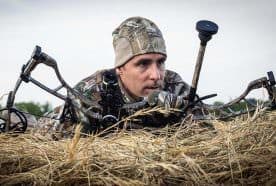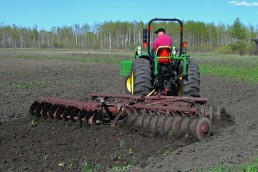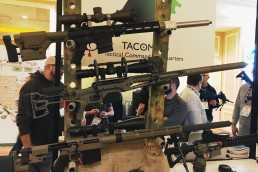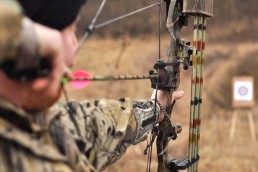Choose the Right Stabilizer to Add 10 Yards to Your Range
SHARE THIS POST
In bowhunting big game, the hardest part is getting close—dangerously close. It’s something bowhunters strive toward each year. Putting a big mature buck inside the kill zone will drive a hunter crazy. What happens if he is broadside just outside your comfortable shooting zone? Instead of having him outside the zone, what if you learned to extend that range by an extra 10 yards? Would you take that advantage?
The right hunting stabilizer will help provide the extra downrange accuracy and extend your effective yardage. Stabilizers are often purchased as an afterthought or another accessory. In reality stabilizers serve three main functions: reduce hand shock, bow noise and vibration and hold the bow steady while shooting and balancing the bow.
When shooting a bow, the energy used to fire vibrates the entire bow and any attached components. A stabilizer often has rubber noise-dampening material to absorb excess energy from the shoot recoil, reducing noise. In addition, a stabilizer with some forward weight will help the hunter hold steady for better shot placement by weighing down the bow, making it steadier to hold in place.
Vibration reduction
Stabilizers with noise-dampening material help greatly absorb the sound. Longer stabilizers with weight on the end of the stabilizer help the archer reduce torque and let the pins settle in. Hunting bows can sometimes feel lopsided: One side has sights, quivers, and accessories bolted on, which can cause hand torque. This can make the bow improperly balanced, so a side bar attached to the opposite side will help resolve the problem.

Now we have started to get to the extreme and have to understand the purpose. As a bowhunter, I need to understand my effective shooting range, and at what distance I can take an animal—hunting terrain dictates this. In the western states, longer range is often a necessity. Here in the Midwest, most archers don’t have many opportunities outside of 30 yards. The longer the distance, the more you need to worry about perfect balance and longer stabilizers. In addition, hunters should consider the hunting situation, such as navigating around tree limbs or being confined inside a ground blind. Longer stabilizers could get in the way when navigating around tree limbs or when confined inside a ground blind.
Steady shooting
To help select the perfect stabilizer, I consulted Henry Bass, a professional archer and bowhunter. He is an experienced long-distance competition shooter who also applies his experience toward real hunting situations.
“There is not a recommended length or weight,” Bass said, when asked what would be an optimal stabilizer for a whitetail hunter. “Each hunters’ needs are different, and they need to fit a stabilizer to their situation.”
Stabilizer length can also be deceiving when comparing a 6- and 10-inch stabilizer. Many think that longer must provide better downrange accuracy.
“The longer the stabilizer, the less weight it takes to stabilize the bow,” Bass says. “Shorter stabilizers need more weight to perform the same.”
This means that if space is an issue, a shorter but heavier stabilizer should be used. If space weren’t a concern, using a 10-inch stabilizer would be lighter while proving the same stability. In hunting conditions, it is very typical to hold a bow for extended periods of time, making overall weight a concern. For optimal bow stability, a long, non-flexible, weight-forward design is vital. Having a stabilizer with a majority of the weight on the front allows for maximum control.
Are you enjoying this post?
You can be among the first to get the latest info on where to go, what to use and how to use it!
Bows have become so much lighter and shorter lately that some I have fired feel too light. There is a balance to the mass weight of a bow. A heavier and longer axle-to-axle bow will often feel better to shoot. And a stabilizer can help provide that weight to a lighter, shorter bow.
There are lots of extremely short stabilizers in the range of 3 to 5 inches on the shelves today. These do little for steadying the shot and are typically pure shock absorption. Most are made from rubber dampening material and work well to absorb vibration. Longer stabilizers that do not have weight on the end also do little for stabilizing the shot, while only serving as a noise reducer.
Perfect balance
Each bow is unique and has weight distributed differently throughout the bow with imbalances causing torque. A side stabilizer can help by counterbalancing the weight of the sight and quiver. Most hunters have not used them because of bulk and weight. These have recently become smaller and are more feasible to use. Some of the newer bows are also offsetting the stabilizer brackets, which helps balance the weight of the bow after the accessories have been bolted on.
One of the trends with today’s bows is that some are top-heavy; after shooting, they will roll forward. With bows that are not balanced perfectly, a short stabilizer attached to the back right below the bow grip can counter this problem.
In the woods
Chasing down whitetails with archery equipment is my passion. I don’t care about competing for national titles, just hunting. So I was extremely intrigued to find out if long stabilizers really increase my accuracy and extend my range on the hunt.
Several of us tested with a variety of lengths: 3-, 5-, 7- and 10-inch stabilizers. We kept track of the average variance to the bullseye. After some extensive shooting and experimenting with the 10-inch stabilizer, I was amazed at the results. There was a distinctive difference for everyone when using the 10-inch stabilizer over a shorter counterpart.
Simply adding a weight-forward stabilizer had a great impact. This had more influence at greater distances and arrow groups improved. While shooting, the sight pin settles into the bullseye. While aiming, my holding patterns changed from jittery to slow, smooth movement. The largest impact was at 30 yards and beyond—anyone looking for improved accuracy at longer ranges should begin to utilize a stabilizer to improve accuracy.
After the testing, I equipped my bow with a 10-inch stabilizer to see if it was too cumbersome for use in the woods. As a whitetail hunter, who utilizes a combination of ground blinds and treestands, would a 10-inch stabilizer be feasible? I found that although it was longer than my previous stabilizer, it usually did not get in the way. Many newer bows have a reflex riser design; therefore a stabilizer doesn’t stick out too far. Many hunters, including myself, typically use a 7-inch stabilizer, so adding an extra 3 inches along with some weight did not seem extreme. And it did not get caught on branches or ground blind walls. Although in a small ground blind, length would become an issue. In those situations, a shorter, heavier stabilizer would be ideal.
Using a longer stabilizer is a small change that could greatly improve an average hunter’s arrow groups. For a hunter who is focusing maximum range at 30 yards, a long stabilizer would have a minimal impact. My assessment indicates control is most successfully impacted at 60 yards or beyond. If you want to extend your range, a longer stabilizer is an impactful tool.
MWO
SHARE THIS POST
Did you enjoy this post?
You can be among the first to get the latest info on where to go, what to use and how to use it!
Brian Miller
MidWest Outdoors works with more than 200 outdoor experts each year, who contribute articles based on their areas of expertise. MidWest Outdoors magazine offers more fishing and hunting articles than any other publication!




Excellent article!!! Thank you.